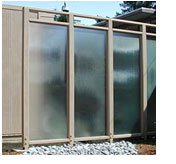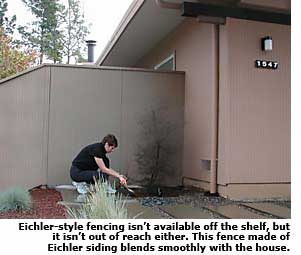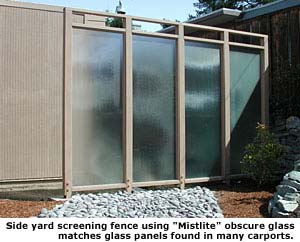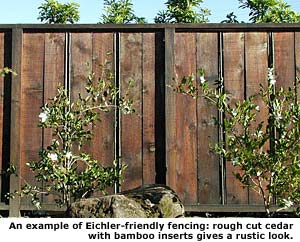Eichler Exterior Upgrades
 Eichler owners everywhere are confronting the same challenge: after five decades or more, the exterior of their house can require a lot of attention. Whether it is deteriorating siding, rusting light fixtures, fences falling over, or doors delaminating, the household maintenance 'to do' list never seems to get shorter.
Eichler owners everywhere are confronting the same challenge: after five decades or more, the exterior of their house can require a lot of attention. Whether it is deteriorating siding, rusting light fixtures, fences falling over, or doors delaminating, the household maintenance 'to do' list never seems to get shorter.
A desire for more interior space in their modest 1950s-era homes has gotten some Eichler dwellers dreaming of magnificent room additions, alterations that have the potential to radically modify the structure. Whatever the change, large or small, the question remains: how to maintain the unique character of these homes?
"Don't deny the house." These are words of wisdom to live by. They come from one of Eichler's principal architects, A. Quincy Jones, who made that statement many years ago to emphasize that modifications to an Eichler's design should be in keeping with the architect's original aesthetic. In the case of Eichler homes, the aesthetic is mid-century modern—a clean, distinctive style that still looks contemporary today. Interrupting the architect's original direction, such as adding a bay window or plopping a steeply pitched roof on a flat-roofed model, can have disastrous effects, even to the point of adversely impacting the home's resale value, according to realtors who specialize in Eichlers.
It's certainly true that maintaining the Eichler look, whether adding a room or just replacing a light fixture, isn't always easy, especially given that the large-chain home-improvement stores don't have 'Eichler replacement parts' departments. Fortunately, creative Eichler owners have developed their own solutions; and service providers, several of whom uphold the Eichlers' original aesthetic, have sprung up to service the Eichler communities.

Fencing is one item that often needs attention, and long before the 50-year mark. While Eichler-style fencing isn't available off the shelf, that doesn't mean it's time to give up and take the white-picket route. Sunnyvale Eichler owners Leslie and Tod Fitch stayed true to the aesthetic: "We wanted to match the original fence, though it took us a while to convince the contractor. He tried to talk us into a fence that looked more appropriate to an Arts and Crafts bungalow than an Eichler!" The contractor milled the new fencing material to these dimensions on site: grooves 1-3/4 inches on center, groove width 5/8 inch, groove depth 3/8 inch. A similar approach was taken by San Jose owner Cathye Smithwick, who used Eichler-style siding to face her fence, saying, "It gave us the continuous, simple look we were after."
For those Eichler owners who have atrium models in which the carport divider is composed of panels of obscure glass, consider building a front yard fence that matches the look of the divider. Create a wood frame that incorporates matching panels of obscure glass for a truly sophisticated look. A contemporary glass style that closely matches that used by Eichler is 'Mistlite,' sold by ACI Distribution through local glass dealers. Warning: even short runs of a style like this can end up costing up to $100 per linear foot just for materials. However, the level of skill required to build it is not great, and many homeowners can handle most fence construction as a 'do it yourself' project.
Typically, fences rot away and need replacing because the posts are sunk into concrete that is level with the ground. Dirt and debris build up around the base of the posts, providing bacteria and fungi a hospitable environment in which to thrive. Consider this approach to extending the life of your fence. Use metal post bases (made by Simpson Strong-Tie, for example, approximately $12 each) and bolt the posts to them after sinking the bases into concrete. Leave a two-inch gap below the post and the base plate to allow air to circulate. Be sure to paint or treat the underside of the post to protect it.
While Simpson says their post bases are for weight-bearing posts only, not freestanding fence posts, in fact they work very well in this application (hurricane force winds excepted). Master carpenter Al Triguerio puts it this way: "I won't put wood posts into concrete anymore because they just don't last. I always use metal post bases. Good wood is just too expensive to replace every 25 years!"






